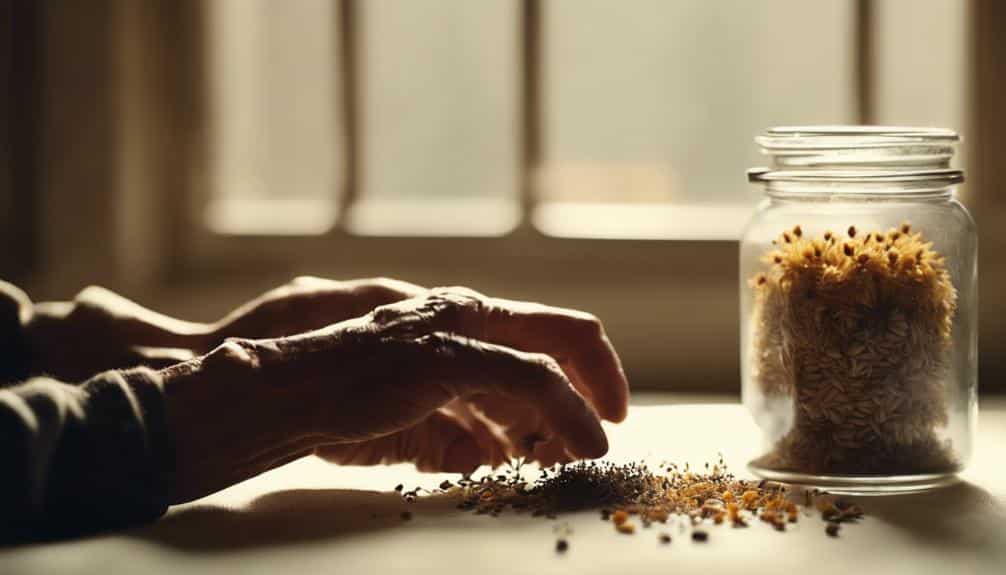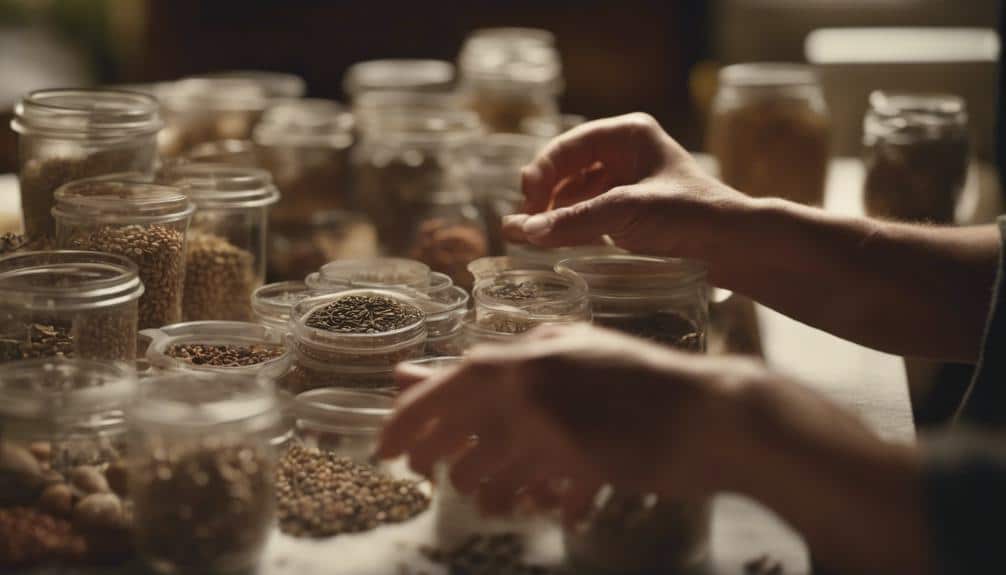To set yourself up for a flourishing garden next year, get a grip on seed saving and storage.
Keep seeds in a cool, dark, and dry spot. Safeguard them in airtight containers like glass jars or seed envelopes. Label each container with seed details and when you stored them.
Stick with only top-quality, mature seeds. Regularly check for any harm. Oh, and if you’re curious about drying seeds for planting or trying out different storage methods, there’s more to discover.
We wrote this article to share seed saving techniques especially for heirloom varieties. While saving seeds for future gardening needs it's beneficial to learn canning and preserving your urban garden produce.
What is seed storing?

Seed storing is essential for keeping seeds viable until the next planting season. Ensure seeds are dry before storing to prevent mold and rot.
Store seeds in cool, dry conditions away from sunlight. Use airtight containers like glass jars or seed envelopes for storage. This method maintains seed viability by protecting them from moisture, light, and temperature changes.
Can seeds be used next year?
To ensure seeds are viable next year, store them properly. Keep seeds in a cool, dark, dry place. Use airtight containers like glass jars or resealable plastic bags to protect against humidity and pests. Label each container with the seed type and storage date.
Only store mature, healthy seeds. Immature or damaged seeds likely won’t germinate well next season.
Seed viability varies by type. For example, tomato and pepper seeds can last up to five years, but onion and leek seeds might only be good for one year. Check stored seeds regularly for any signs of damage or decay to maintain their germination potential.
How to dry seeds for plant?

To dry seeds for planting, follow these steps:
- Harvest Seeds: Pick seeds from mature, healthy plants. Ensure the seeds are fully developed before harvesting.
- Clean Seeds: Remove debris, pulp, or flesh. If needed, rinse seeds to eliminate residue. Use a fine mesh strainer for effective cleaning.
- Air Dry Seeds: Spread seeds in a single layer on a paper towel or mesh screen. Place in a warm, dry, well-ventilated area. Avoid direct sunlight to prevent damage.
Drying seeds properly prevents mold and improves germination rates. Make sure they’re completely dry before sowing.
How to store seeds for next year?
When storing seeds for the next year, consider the different types of storage available. You should focus on finding the best method that suits the specific seeds you have.
Have you ever wondered if storing seeds in the fridge or freezer is the right choice for maintaining their viability?
Seed storage types
Explore various containers for seed storage to ensure viability during the next planting season:
- Glass jars: These prevent moisture and pests from damaging seeds.
- Plastic bags: Useful for compact storage; keep these in a cool, dry area.
- Envelopes: Ideal for small seed quantities; they simplify labeling.
- Seed tins: A sturdy choice; they offer airtight protection for extended storage.
Each type offers distinct benefits, addressing different storage needs. Choose based on the amount of seeds and the storage duration required.
Best storage for seeds
To keep seeds viable, store them properly. Use a cool, dry location. Avoid sunlight and moisture. Use airtight containers like glass jars or resealable plastic bags. Label each container with the seed type and the date you collected them.
Store seeds in a dark cabinet or drawer to keep the temperature stable. Check seeds regularly for mold or pests. Discard any damaged seeds to prevent issues from spreading. Proper storage extends seed life for future planting.
Should you store seeds in the fridge or freezer?
Storing seeds in a fridge or freezer preserves their viability for future planting. Use these tips:
- Choose airtight containers to protect seeds from moisture and pests.
- Label each container with the seed type and storage date.
- Store seeds at the back of the fridge or freezer for stable temperatures.
- Avoid frequent temperature changes by minimizing the opening of the fridge or freezer.
This method keeps seeds dormant and prevents premature germination.
How long do seeds last if kept dry?
Seeds typically last several years when stored dry. Moisture can degrade seeds, so ensure they’re completely dry before storage. Over time, germination rates of seeds decrease, even in dry conditions. Regularly conduct seed viability tests before planting to check their condition.
Different seed types have various shelf lives. Research your specific seed type for exact longevity. Store seeds in airtight containers in cool, dry places like pantries or cellars. Label each container with the storage date to monitor seed age and viability.
Frequently Asked Questions
Can Seeds From Hybrid Plants Be Saved for Next Year?
Yes, you can save seeds from hybrid plants for next year, but keep in mind that the saved seeds may not produce offspring with the same characteristics as the parent plant due to genetic variations.
Are There Any Special Containers for Seed Storage?
You can use airtight containers like glass jars or resealable bags to store seeds. Make sure to label them with the plant type and date. Keep the containers in a cool, dark place to maintain seed viability.
Is It Necessary to Ferment Seeds Before Planting?
You don’t have to ferment seeds before planting, but it can be beneficial for certain types. Fermentation helps remove germination inhibitors, improving seed viability. Research which seeds benefit from this process for a successful garden.
Can Seeds Be Stored in the Freezer for Long-Term Preservation?
Yes, you can store seeds in the freezer for long-term preservation. It helps maintain their viability by slowing down the aging process. Make sure to use airtight containers and label them properly for easy identification.
How to Determine if Saved Seeds Are Still Viable for Planting?
To determine if saved seeds are still viable for planting, conduct a germination test. Place a few seeds on a damp paper towel, keep it moist, and monitor for sprouting. If most seeds germinate, they are likely still good for planting.
